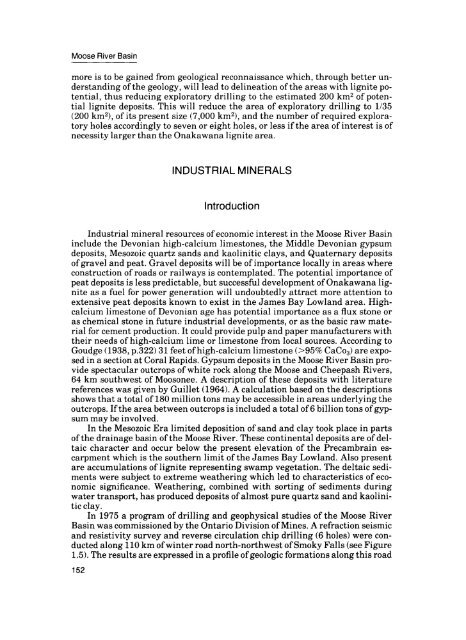Moose River Basin: geology and mineral potential - Geology Ontario
Moose River Basin: geology and mineral potential - Geology Ontario
Moose River Basin: geology and mineral potential - Geology Ontario
You also want an ePaper? Increase the reach of your titles
YUMPU automatically turns print PDFs into web optimized ePapers that Google loves.
<strong>Moose</strong> <strong>River</strong> <strong>Basin</strong><br />
more is to be gained from geological reconnaissance which, through better un<br />
derst<strong>and</strong>ing of the <strong>geology</strong>, will lead to delineation of the areas with lignite po<br />
tential, thus reducing exploratory drilling to the estimated 200 km 2 of poten<br />
tial lignite deposits. This will reduce the area of exploratory drilling to 1/35<br />
(200 km 2), of its present size (7,000 km 2), <strong>and</strong> the number of required explora<br />
tory holes accordingly to seven or eight holes, or less if the area of interest is of<br />
necessity larger than the Onakawana lignite area.<br />
INDUSTRIAL MINERALS<br />
Introduction<br />
Industrial <strong>mineral</strong> resources of economic interest in the <strong>Moose</strong> <strong>River</strong> <strong>Basin</strong><br />
include the Devonian high-calcium limestones, the Middle Devonian gypsum<br />
deposits, Mesozoic quartz s<strong>and</strong>s <strong>and</strong> kaolinitic clays, <strong>and</strong> Quaternary deposits<br />
of gravel <strong>and</strong> peat. Gravel deposits will be of importance locally in areas where<br />
construction of roads or railways is contemplated. The <strong>potential</strong> importance of<br />
peat deposits is less predictable, but successful development of Onakawana lig<br />
nite as a fuel for power generation will undoubtedly attract more attention to<br />
extensive peat deposits known to exist in the James Bay Lowl<strong>and</strong> area. Highcalcium<br />
limestone of Devonian age has <strong>potential</strong> importance as a flux stone or<br />
as chemical stone in future industrial developments, or as the basic raw mate<br />
rial for cement production. It could provide pulp <strong>and</strong> paper manufacturers with<br />
their needs of high-calcium lime or limestone from local sources. According to<br />
Goudge (1938, p.322) 31 feet of high-calcium limestone ^957c CaCo3 ) are expo<br />
sed in a section at Coral Rapids. Gypsum deposits in the <strong>Moose</strong> <strong>River</strong> <strong>Basin</strong> pro<br />
vide spectacular outcrops of white rock along the <strong>Moose</strong> <strong>and</strong> Cheepash <strong>River</strong>s,<br />
64 km southwest of Moosonee. A description of these deposits with literature<br />
references was given by Guillet (1964). A calculation based on the descriptions<br />
shows that a total of 180 million tons may be accessible in areas underlying the<br />
outcrops. If the area between outcrops is included a total of 6 billion tons of gyp<br />
sum may be involved.<br />
In the Mesozoic Era limited deposition of s<strong>and</strong> <strong>and</strong> clay took place in parts<br />
of the drainage basin of the <strong>Moose</strong> <strong>River</strong>. These continental deposits are of del<br />
taic character <strong>and</strong> occur below the present elevation of the Precambrain es<br />
carpment which is the southern limit of the James Bay Lowl<strong>and</strong>. Also present<br />
are accumulations of lignite representing swamp vegetation. The deltaic sedi<br />
ments were subject to extreme weathering which led to characteristics of eco<br />
nomic significance. Weathering, combined with sorting of sediments during<br />
water transport, has produced deposits of almost pure quartz s<strong>and</strong> <strong>and</strong> kaolini<br />
tic clay.<br />
In 1975 a program of drilling <strong>and</strong> geophysical studies of the <strong>Moose</strong> <strong>River</strong><br />
<strong>Basin</strong> was commissioned by the <strong>Ontario</strong> Division of Mines. A refraction seismic<br />
<strong>and</strong> resistivity survey <strong>and</strong> reverse circulation chip drilling (6 holes) were con<br />
ducted along 110 km of winter road north-northwest of Smoky Falls (see Figure<br />
1.5). The results are expressed in a profile of geologic formations along this road<br />
152

















